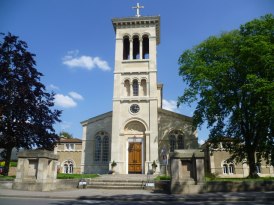Just before I started my PhD at Kingston University in 2012, I took part in the Kingston Heritage Trails project. The project was a collaborative effort between the Centre for the Historical Record, Kingston’s Sustainability Hub and Kingston Museum. It was part of a bigger project, Kingston Trails, which aimed to highlight the green and historic aspects of our local area.
My part in Kingston Heritage Trail involved picking a historic site, researching it, writing a short script about its history and then, terrifyingly, presenting this to camera. When I did my MA at Kingston, I’d been very lucky to take on a placement at Lion Television but I had been very much behind the scenes rather than in front of a camera, so the prospect of becoming a ‘TV historian’ for a day was daunting.
Nick Barratt from Sticks Research Agency and The National Archives came into Kingston to talk to myself and other people involved in the project, to give us advice about turning historical research into something presentable to camera, and in turn to a wider audience than most of us were used to.
The site I chose was St. Raphael’s Catholic Church on Portsmouth Road. I had never heard of the church, let alone been inside, so heading to the Kingston History Centre to start my research I had no idea what to expect. In the archives, I found a rich history with a fantastic narrative, and plenty of historic images of the church, which were used to supplement the write up of my research on the Kingston Heritage Trail website. I was used to doing archival research and writing this up, but for academic purposes rather than a public audience.
A big part of this challenge was the time and word limit constraints. Being used to long essays and dissertations, the prospect of turning my research into a word limit that had to fit within a time constraint of about three minutes was more trying than I had anticipated. However, it taught me a great deal about the way that television history works in small snippets that produce soundbites.
Once I had written it, the real challenge came – presenting to a camera. Inside a church no less, it was a daunting experience. Having spent my school years in Catholic education, and from an Irish Catholic background, I had to get over the idea of speaking loudly in church (before even being fitted with a microphone and considering how the acoustics sounded).
One of the biggest lessons I learnt was about the practicalities of filming and being filmed. Like lots of clips in history documentaries, my piece required me to be filmed in front of several backdrops, presenting inside and outside, as well as walking into the church. However, on the day cameraman Justin Howard, Elise Barron from the Sustainability Hub (my moral support for the day) and I turned up, it was tipping it down with rain. We filmed inside the church that day, and returned the next week to film outside. The day we returned happened to be the beginning of a heat wave, so I had to boil in the clothes I’d worn the week before for the sake of continuity. The church was locked on this day too, so the shot of me walking up to go inside the church is actually a mix of clever camera angles and me being squashed against a door (which took several attempts to get right).
I hadn’t ever considered these practical problems before – at Lion my work had been in the development stage, and my usual academic practical problems lay in not having a sharpened pencil or being out of tea. There are of course similarities in academic and public history – in my own experience, both of these start in an archive (or at least with primary sources), but the path they take is very different. The greatest difference to me was the extra limitation of time and length in presenting to camera. I did find though that this limitation could also be a positive, in that it made me consider the most important aspects of my research and the narrative. Indeed, the whole experience shone a new light on how to produce history and turn archival research into public history in several formats – written, presented to camera, and digitally in the form of a trail.
You can see the full Kingston Heritage Trail online here, and watch my short film on St. Raphael’s below.
Claire Hayward, PhD Student at Kingston University


Reblogged this on exploring public histories and commented:
I contributed to the Kingston Heritage Trail in 2012 – you can read about my experience of being a ‘talking head’ historian and watch the result on History@Kingston.
LikeLike
Pingback: Around the World from Rio de Janeiro, Sydney and London — New Talent Joins the Student & New Pro Committee | IFPH-FIHP